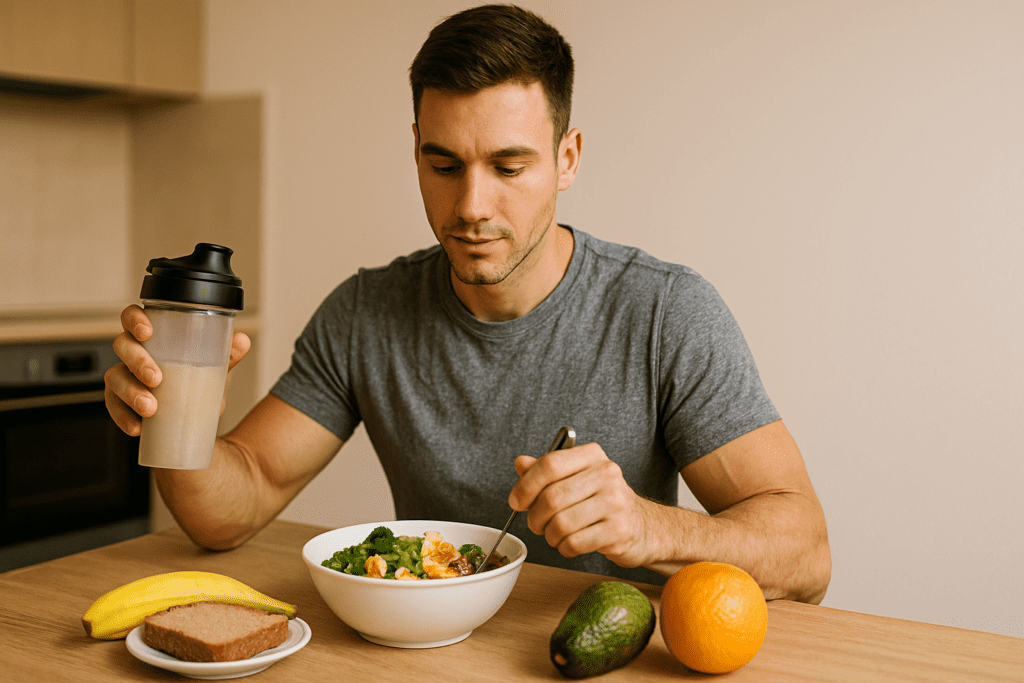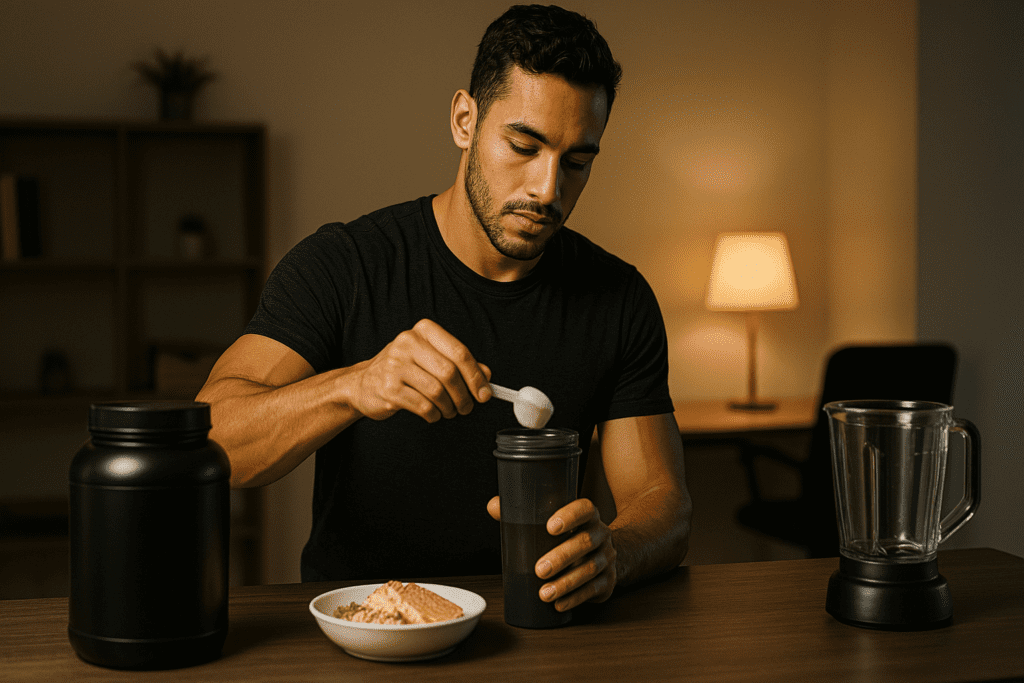In today’s fast-paced world, a well-structured nutrition plan for working out is no longer a luxury reserved for elite athletes. It has become a foundational element for anyone aiming to improve their health, support physical performance, and maintain an active lifestyle. Whether you’re an amateur gym-goer, a seasoned lifter, or someone returning to exercise after a break, understanding how to nourish your body with the right foods is essential. A balanced diet can optimize your workouts, enhance recovery, and help you stay in shape without sacrificing long-term wellness.
You may also like: Smart Healthy Eating Tips for Busy Professionals: How to Stay Nourished When You’re Always on the Go
Nutrition is intricately tied to how the body responds to exercise. Food is more than just fuel; it is a tool for transformation. Choosing the best foods to eat every day to stay in shape ensures that you’re not only feeding your muscles but also protecting your metabolism, stabilizing energy levels, and promoting overall mental clarity. In this guide, we’ll explore how to create a fitness diet plan that aligns with your workout goals, fits into a busy lifestyle, and reflects current research on optimal dietary patterns for strength, endurance, and recovery.
The Science Behind a Fitness-Focused Diet
At its core, a fitness diet plan must address the body’s fundamental macronutrient needs: carbohydrates, proteins, and fats. Carbohydrates serve as the primary energy source for high-intensity workouts, while protein is essential for muscle repair and growth. Healthy fats support hormonal balance and assist in nutrient absorption, making them a crucial component of any well-rounded exercise meal plan. Understanding the balance between these nutrients is key to ensuring peak performance during training sessions and faster recovery afterward.
Beyond macronutrients, micronutrients play a supportive but no less significant role. Vitamins and minerals are often the unsung heroes in athletic performance. Iron, for example, is vital for oxygen transport, while magnesium supports muscle relaxation and helps prevent cramps. B vitamins are deeply involved in energy metabolism, and calcium is essential for strong bones and muscle contractions. A gym diet that ignores micronutrient density will ultimately fall short, even if the macronutrient ratios are on point.
Additionally, the timing of meals matters. Consuming the right nutrients before and after exercise can significantly impact how the body adapts to training. A strategic pre-workout snack high in complex carbohydrates and a small amount of protein can sustain energy levels and reduce fatigue. Post-workout, the focus shifts to replenishing glycogen stores and kickstarting muscle repair. This is where high-quality protein sources and fast-absorbing carbohydrates come into play, making them key players in any effective meal plans for fitness.

Choosing the Best Foods to Eat Every Day to Stay in Shape
Consistency is the cornerstone of long-term success, and this applies not only to training routines but also to dietary habits. Integrating the best foods to eat every day to stay in shape into your routine creates a foundation for physical and metabolic resilience. Whole foods rich in fiber, antioxidants, and essential nutrients offer benefits that extend beyond body composition. They support cardiovascular health, cognitive function, and immune defense, creating a synergistic environment for both fitness and longevity.
Start with lean protein sources like chicken breast, turkey, eggs, Greek yogurt, tofu, and legumes. These not only promote muscle maintenance but also support satiety, which helps manage overall calorie intake. Complex carbohydrates such as quinoa, brown rice, oats, and sweet potatoes provide sustained energy and reduce the risk of insulin spikes that lead to fatigue and cravings. These staples should be cornerstones of a workout and eating plan focused on long-term health and sustainability.
Incorporating healthy fats is equally important. Foods like avocados, olive oil, nuts, and seeds offer anti-inflammatory benefits and help stabilize mood and hormones, which can be particularly important during periods of intense training. Leafy greens, cruciferous vegetables, and brightly colored fruits should round out the plate to ensure an adequate intake of vitamins, minerals, and antioxidants. These foods contribute to cellular repair and help counteract oxidative stress, an often-overlooked factor in workout recovery.
Designing an Exercise Meal Plan That Supports Your Goals
Creating an effective exercise meal plan requires more than randomly assembling healthy foods. It involves tailoring your dietary strategy to meet the unique demands of your workout regimen, body composition goals, and lifestyle constraints. For those aiming to build muscle, an emphasis on protein intake, particularly spaced throughout the day, becomes critical. Research suggests that distributing protein intake evenly across meals can enhance muscle protein synthesis more effectively than skewing intake toward a single meal.
Those training for endurance or high-volume output need to focus on glycogen preservation and replenishment. This means consuming adequate carbohydrates before and after workouts, particularly on high-intensity training days. An appropriate balance of macronutrients will prevent the dreaded “bonk” during exercise and ensure you have the energy reserves to sustain performance. Tailoring your meal timing and portion sizes based on your training schedule can make a significant difference in results.
A well-designed fitness diet plan should also accommodate real-life constraints such as work schedules, travel, and social commitments. The best plans are those that are not only scientifically sound but also practically achievable. This may mean preparing meals in advance, incorporating portable snacks, or utilizing balanced meal delivery services. The ultimate goal is to establish a consistent eating pattern that supports your training while being flexible enough to adapt to life’s unpredictability.
The Role of Meal Frequency and Timing in Fitness Nutrition
While the quality of food remains paramount, the frequency and timing of meals can further enhance or undermine the effectiveness of your workout and eating plan. Intermittent fasting has gained popularity in recent years, and while it may offer benefits for some, those engaged in intense training may find that more frequent meals improve energy levels and recovery. Eating every three to four hours can help maintain stable blood sugar levels and provide a steady supply of nutrients to support muscle repair and energy metabolism.
Pre-workout nutrition sets the tone for physical performance. A meal or snack consumed 1-2 hours before exercise should include easily digestible carbohydrates and moderate protein, avoiding high-fat or high-fiber foods that may cause gastrointestinal discomfort. For example, a banana with almond butter or oatmeal with whey protein are simple yet effective pre-workout meals. Post-workout, the focus should shift to recovery. Ideally, aim to consume a combination of protein and carbohydrates within 30 to 60 minutes of completing your workout to capitalize on the anabolic window.
For individuals following a diet while weight training, aligning meal timing with training sessions becomes particularly important. Strategic nutrient timing can enhance protein synthesis, support hormonal balance, and reduce muscle soreness. Even rest days should include balanced meals to facilitate muscle repair and prevent nutrient depletion. By respecting the interplay between meal timing and workout intensity, individuals can create a gym diet that works in harmony with their training objectives.
Building a Gym Diet That Supports Strength and Recovery
Weight training demands a specific nutritional strategy focused on building and preserving lean muscle mass while promoting efficient recovery. A gym diet for lifters should emphasize high-quality protein sources, ideally with a complete amino acid profile. Animal-based proteins like lean meats, dairy, and eggs are complete sources, while plant-based eaters can achieve the same benefits by combining legumes, grains, nuts, and seeds.
Carbohydrates should not be neglected in a gym diet. While low-carb approaches have gained traction, they may not provide sufficient fuel for high-intensity resistance training. Carbs play a crucial role in replenishing glycogen stores and preventing muscle breakdown, particularly when consumed around training sessions. Including starchy vegetables, fruits, and whole grains ensures a robust intake of both simple and complex carbohydrates that support endurance and repair.
Hydration is another often-overlooked aspect of recovery. Muscles are composed largely of water, and even mild dehydration can impair strength and coordination. Consuming electrolyte-rich fluids, especially after intense sessions or when training in heat, is vital. Coconut water, sports drinks, or simply adding a pinch of salt and lemon to water can help restore electrolyte balance. These small adjustments can turn an average fitness diet plan into one that supports both performance and long-term gains.

Adapting Meal Plans for Fitness Across Different Lifestyles
Fitness nutrition is not one-size-fits-all. A successful nutrition plan for working out must reflect the unique preferences, dietary restrictions, and cultural considerations of the individual. Vegetarians and vegans, for instance, must be intentional about sourcing complete proteins and ensuring adequate intake of nutrients such as iron, vitamin B12, and omega-3 fatty acids. Incorporating foods like lentils, tempeh, nutritional yeast, and algae-based supplements can help bridge the gap.
Busy professionals might struggle with meal timing or preparation, making convenience a key factor. For them, simple strategies such as overnight oats, smoothies, and batch-cooked grain bowls can reduce reliance on processed convenience foods. Fitness-oriented meal plans can also leverage technology, such as nutrition tracking apps or smart kitchen appliances, to simplify planning and promote accountability. These tools can help maintain consistency and track progress without becoming burdensome.
Similarly, individuals managing metabolic conditions or weight concerns may need to emphasize portion control and glycemic balance. Focusing on low-glycemic index foods, adequate fiber, and nutrient-dense ingredients can help regulate appetite and blood sugar while supporting lean muscle development. A thoughtful, individualized approach makes the exercise meal plan not just effective but sustainable, ultimately supporting lifelong health.
Sustaining Long-Term Results Through Mindful Eating Practices
No matter how detailed or precise your fitness diet plan is, its effectiveness depends on your relationship with food. Mindful eating—paying attention to hunger cues, emotional triggers, and eating environments—can transform how you experience and adhere to your nutrition plan. Practicing mindfulness during meals helps prevent overeating, supports digestion, and reinforces the connection between food and body awareness.
Moreover, sustainability should always outweigh perfection. Rather than chasing dietary extremes or unsustainable cleanses, focus on gradual, consistent progress. Allowing flexibility for social occasions, travel, and indulgences ensures that the workout and eating plan remains an enjoyable part of life rather than a source of stress. Incorporating diverse flavors, experimenting with new recipes, and honoring cultural food traditions can further enrich the experience.
By cultivating awareness and patience, individuals can create a positive feedback loop where healthy eating becomes intuitive and rewarding. This mindset not only supports immediate fitness goals but also fosters resilience in the face of life’s inevitable challenges. Over time, the integration of sound nutrition and self-awareness becomes the bedrock of a healthier lifestyle.
Frequently Asked Questions: Smart Nutrition and Fitness Meal Planning
What’s the best way to adjust my nutrition plan for working out when transitioning from beginner to intermediate training?
As your training intensity increases, your nutrition plan for working out must evolve to support greater energy demands and recovery needs. One of the most overlooked shifts is the need for improved intra-workout fueling, particularly through easily digestible carbs like fruit-based smoothies or electrolyte drinks. Intermediate routines often involve more volume and frequency, which can increase nutrient turnover—especially for B vitamins, magnesium, and zinc. Adjust your macronutrient ratios gradually, with a moderate increase in protein and carbs, while monitoring how your body responds to dietary changes. It’s also useful to begin periodizing your meal plans for fitness, varying caloric intake and food timing depending on workout intensity across the week.
Can a fitness diet plan still be effective if I work out at night?
Absolutely. Many people thrive on evening training schedules, but your fitness diet plan needs to reflect that timing to be effective. Focus on having a balanced pre-workout meal about 90 minutes before your session, combining complex carbs and lean protein. After evening workouts, many skip post-exercise meals due to sleep concerns, but this can hinder recovery. Consider light yet nourishing options like a protein shake with oats or Greek yogurt with berries—both of which align with a sound workout and eating plan. Prioritize foods that promote muscle repair without being too heavy on digestion.
How can I make an exercise meal plan that works while traveling or eating out frequently?
Travel and social dining can challenge even the most disciplined exercise meal plan, but flexibility is key. Look for restaurants with customizable meals—think lean proteins, grilled vegetables, and whole grains. Keep protein bars, pre-portioned trail mix, or individual nut butter packs on hand as mobile-friendly options. When possible, opt for accommodations with a kitchenette or mini-fridge to allow light meal prep. Ultimately, a sustainable nutrition plan for working out during travel doesn’t demand perfection, but it does benefit from intentional choices that prioritize nutrient density and balance.
What are some underrated best foods to eat every day to stay in shape that people often overlook?
While staples like chicken breast and brown rice are popular, several highly nutritious options are frequently overlooked. Canned sardines, for instance, offer a powerful blend of omega-3s, protein, and calcium—ideal for joint health and inflammation reduction. Fermented foods like kimchi and kefir support gut health, which influences everything from nutrient absorption to immune response. Chia seeds are another unsung hero, providing fiber and omega-3s that aid satiety and metabolic balance. Including these foods can elevate a gym diet from adequate to exceptional, supporting both performance and long-term wellness.
How does eating for weight training differ from eating for cardio-based training?
Eating for weight training involves a different macronutrient emphasis compared to cardio-centric routines. Resistance training places a higher demand on protein for muscle synthesis and carbohydrates for glycogen restoration post-lift. On the other hand, cardio-heavy regimens rely more on sustained carbohydrate intake to fuel endurance. A diet while weight training should emphasize strategic protein spacing throughout the day, often in the form of 20-30 gram servings every 3-4 hours. Meanwhile, cardio plans may benefit from carb-dense snacks before and during long sessions, especially for those doing fasted workouts or training for endurance events.
What’s a practical strategy for beginners to start a sustainable gym diet without feeling overwhelmed?
Simplicity and routine are your allies when beginning a gym diet. Rather than obsessing over tracking every macro, start by standardizing one or two meals per day with balanced components: a protein source, a complex carb, a vegetable, and a healthy fat. Meal prepping on Sundays and Wednesdays can help maintain consistency without burnout. Think of your gym diet as a long-term framework—not a rigid rulebook—so experiment with different foods and preparation methods to keep meals enjoyable. Gradually introduce diversity over time while keeping an eye on how your energy, sleep, and performance respond.
How can meal plans for fitness be tailored to support hormonal balance, especially for women?
Hormonal fluctuations can influence hunger, energy levels, and nutrient needs—especially in women. Meal plans for fitness should include sufficient dietary fat to support estrogen production and avoid extremely low-carb phases that may disrupt hormonal rhythms. Foods like flaxseeds, fatty fish, avocados, and dark leafy greens provide crucial micronutrients like omega-3s, magnesium, and iron, which are often depleted during menstruation. Consider tracking cycles and adjusting your fitness diet plan accordingly—for example, emphasizing recovery-supportive foods during the luteal phase when inflammation and cravings may increase. Tailoring your workout and eating plan around these patterns can improve consistency and overall well-being.
Is intermittent fasting compatible with a structured nutrition plan for working out?
It can be, but success largely depends on the type and timing of your workouts. If your training sessions occur during your eating window, intermittent fasting can align with a nutrition plan for working out without compromising performance. However, fasted resistance training without adequate pre- or post-workout nutrition may impair muscle recovery and strength gains. To reconcile both approaches, many athletes use a modified fast with a protein-rich pre-workout supplement or branched-chain amino acids (BCAAs) before training. It’s essential to prioritize nutrient timing within your fasting window to maintain muscle mass and recovery within an effective exercise meal plan.
What psychological or emotional habits can enhance adherence to a workout and eating plan?
Long-term adherence to a workout and eating plan often hinges more on mindset than meal structure. Cultivating self-compassion is critical; all-or-nothing thinking often leads to burnout or guilt after minor slip-ups. Setting small, achievable goals—like prepping lunches for three days instead of seven—can build confidence. Incorporating enjoyable foods, celebrating non-scale victories, and viewing food as nourishment rather than reward help reinforce positive behaviors. Emotional resilience, not just physical discipline, sustains both the gym diet and your broader health journey.
Can advanced athletes still benefit from revisiting the basics of eating for weight training?
Absolutely. Over time, even experienced lifters can fall into habits that undercut their goals, such as underestimating recovery nutrition or over-relying on supplements. Re-grounding in the fundamentals of eating for weight training—consistent protein intake, strategic carb timing, and balanced micronutrient consumption—often reveals gaps in an otherwise polished routine. Additionally, as training ages or body composition goals shift, the demands of the fitness diet plan may evolve. Regularly reassessing foundational habits ensures that your diet while weight training continues to support progress rather than plateauing performance. It’s a reminder that mastery often lies in refining the basics, not abandoning them.

Conclusion: Integrating a Smart Nutrition Plan for Working Out Into a Healthier Lifestyle
Crafting a smart nutrition plan for working out goes beyond tracking calories or hitting protein targets. It involves understanding how to nourish your body with intention, aligning dietary strategies with your fitness goals, and recognizing the profound impact of everyday food choices on performance, recovery, and long-term health. By focusing on the best foods to eat every day to stay in shape, you build a foundation of wellness that supports both physical endurance and mental clarity.
When you approach fitness meal plans with a blend of scientific insight and practical application, the results are transformative. A well-structured fitness diet plan enhances your ability to train harder, recover faster, and stay motivated over the long haul. Whether your focus is on strength training, cardiovascular endurance, or general wellness, your workout and eating plan must be cohesive, flexible, and sustainable.
Ultimately, the key to success lies in personalization. There is no universal blueprint for optimal health, but by integrating expert guidance with your unique lifestyle, preferences, and goals, you can create a gym diet that truly works for you. Prioritize nutrient density, respect your body’s signals, and embrace a mindful approach to eating. In doing so, you turn your nutrition plan into a powerful ally—one that fuels not just your workouts, but your entire journey toward a healthier, more fulfilling life.
healthy meal prep ideas, post-workout recovery foods, balanced macronutrient meals, lean protein sources, high-protein meal prep, carb loading for athletes, muscle recovery nutrition, nutrient-dense meal planning, metabolism boosting foods, hydration and fitness, strength training nutrition, foods that support endurance, healthy lifestyle habits, functional fitness fuel, optimal workout recovery, clean eating for athletes, pre-workout energy foods, anti-inflammatory diet for fitness, holistic fitness nutrition, healthy eating habits for athletes
Further Reading:
Keep Active & Eat Healthy to Improve Well-being & Feel Great
Eating the Right Foods for Exercise
Disclaimer
The information contained in this article is provided for general informational purposes only and is not intended to serve as medical, legal, or professional advice. While NewsHealthWatch strives to present accurate, up-to-date, and reliable content, no warranty or guarantee, expressed or implied, is made regarding the completeness, accuracy, or adequacy of the information provided. Readers are strongly advised to seek the guidance of a qualified healthcare provider or other relevant professionals before acting on any information contained in this article. NewsHealthWatch, its authors, editors, and contributors expressly disclaim any liability for any damages, losses, or consequences arising directly or indirectly from the use, interpretation, or reliance on any information presented herein. The views and opinions expressed in this article are those of the author(s) and do not necessarily reflect the official policies or positions of NewsHealthWatch.

